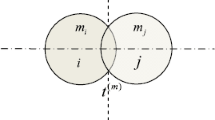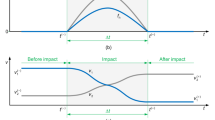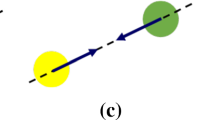Abstract
Continuous contact models have been popular in representing contact forces between impacting bodies of a multibody system. These models consider the contact force to be the result of a logical spring-damper element between the contacting bodies that exists for a very short period. The simplified and approximated model for generating the contact force is then assumed to be a mass-spring-damper system. Therefore, three common parameters that these models require are the spring stiffness, damping coefficient, and the so-called effective mass. For systems containing one degree-of-freedom, classical methods based on the kinetic energy have commonly been used to determine the effective mass. However, for multiple-degree-of-freedom multibody systems that contain kinematic joints, the determination of the effective mass has not been adequately addressed in the literature. This paper proposes a simple method for computing the effective mass based on the concept of impulse–momentum balance. This approach is applicable to both constrained and unconstrained equations of motion regardless of the multibody system’s number of degrees-of-freedom.












Similar content being viewed by others
References
Corral, E., Moreno, R.G., García, M.J.G., Castejón, C.: Nonlinear phenomena of contact in multibody systems dynamics: a review. Nonlinear Dyn. 104(2), 1269–1295 (2021)
Mukherjee, R.M., Anderson, K.S.: Efficient methodology for multibody simulations with discontinuous changes in system definition. Multibody Syst. Dyn. 18(2), 145–168 (2007)
Nikravesh, P.E.: Planar Multibody Dynamics: Formulation, Programming with MATLAB, and Applications, 2nd edn. CRC Press, Boca Raton (2018)
Carvalho, A.S., Martins, J.M.: Exact restitution and generalizations for the Hunt-Crossley contact model. Mech. Mach. Theory 139, 174–194 (2019)
Machado, M., Moreira, P., Flores, P., Lankarani, H.M.: Compliant contact force models in multibody dynamics: evolution of the Hertz contact theory. Mech. Mach. Theory 53, 99–121 (2012)
Wang, G., Liu, C., Liu, Y.: Energy dissipation analysis for elastoplastic contact and dynamic dashpot models. Int. J. Mech. Sci. 221, 107214 (2022)
Jacobs, D.A., Waldron, K.J.: Modeling inelastic collisions with the Hunt-Crossley model using the energetic coefficient of restitution. J. Comput. Nonlinear Dyn. 10(2), 021001 (2015)
Rodrigues da Silva, M., Marques, F., Tavares da Silva, M., Flores, P.: A compendium of contact force models inspired by Hunt and Crossley’s cornerstone work. Mech. Mach. Theory 167, 104501 (2022)
Anagnostopoulos, S.A.: Pounding of buildings in series during earthquakes. Earthq. Eng. Struct. Dyn. 16(3), 443–456 (1988)
Flores, P., Machado, M., Silva, M.T., Martins, J.M.: On the continuous contact force models for soft materials in multibody dynamics. Multibody Syst. Dyn. 25(3), 357–375 (2011). https://doi.org/10.1007/s11044-010-9237-4
Hu, S., Guo, X.: A dissipative contact force model for impact analysis in multibody dynamics. Multibody Syst. Dyn. 35(2), 131–151 (2015). https://doi.org/10.1007/s11044-015-9453-z
Hunt, K., Crossley, F.R.E.: Coefficient of restitution interpreted as damping in vibroimpact. J. Appl. Mech. 42(2), 440–445 (1975)
Khulief, Y.A., Shabana, A.A.: Dynamic analysis of constrained systems of rigid and flexible bodies with intermittent motion. J. Mech. Transm. Autom. Des. 108, 38–45 (1986)
Lankarani, H.M., Nikravesh, P.E.: Hertz contact force model with permanent indentation in impact analysis of solids. In: 18th Annual ASME Design Automation Conference (1992). Publ. by ASME
Hertz, H.: Gesammelte Werke, vol. 1. Johann Ambrosius Barth, Leipzig (1895)
Lankarani, H.M.: Canonical equations of motion and estimation of parameters in the analysis of impact problems. Ph.D. thesis, the University of Arizona (1988)
Wang, W., Hua, X., Wang, X., Chen, Z., Song, G.: Advanced impact force model for low-speed pounding between viscoelastic materials and steel. Eng. Mech. (ASCE) 143(12), 04017139 (2017)
Lankarani, H.M., Nikravesh, P.E.: Continuous contact force models for impact analysis in multibody systems. Nonlinear Dyn. 5(2), 193–207 (1994). https://doi.org/10.1007/BF00045676
Ye, K., Li, L., Zhu, H.: A note on the Hertz contact model with nonlinear damping for pounding simulation. Earthq. Eng. Struct. Dyn. 38(9), 1135–1142 (2009). https://doi.org/10.1002/eqe.883
Poursina, M., Nikravesh, P.: Characterization of the damping coefficient in the continuous contact model. J. Comput. Nonlinear Dyn. 15, 091005 (2020)
Poursina, M., Nikravesh, P.: Optimal damping coefficient for a class of continuous contact models. Multibody Syst. Dyn. 50(2), 169–188 (2020). https://doi.org/10.1007/s11044-020-09745-x
Rao, S.S.: Mechanical Vibrations, 5th edn. Pearson Education, Upper Saddle River (2010)
Lankarani, H.M., Ma, D., Menon, R.: Impact dynamics of multibody mechanical systems and application to crash responses of aircraft occupant/structure. In: Pereira, M.F.O.S., Ambrosio, J.A.C. (eds.) Computational Dynamics in Multibody Systems, pp. 239–265. Springer, Dordrecht (1995)
Lankarani, H.M., Nikravesh, P.E.: A contact force model with hysteresis damping for impact analysis of multibody systems. ASME J. Mech. Des. 112(3), 369–376 (1990)
Funding
The authors did not receive support from any organization for the submitted work.
Author information
Authors and Affiliations
Corresponding author
Ethics declarations
Competing Interests
The authors have no relevant financial or non-financial interests to disclose.
Additional information
Publisher’s Note
Springer Nature remains neutral with regard to jurisdictional claims in published maps and institutional affiliations.
Rights and permissions
Springer Nature or its licensor (e.g. a society or other partner) holds exclusive rights to this article under a publishing agreement with the author(s) or other rightsholder(s); author self-archiving of the accepted manuscript version of this article is solely governed by the terms of such publishing agreement and applicable law.
About this article
Cite this article
Nikravesh, P.E., Poursina, M. Determination of effective mass for continuous contact models in multibody dynamics. Multibody Syst Dyn 58, 253–273 (2023). https://doi.org/10.1007/s11044-022-09859-4
Received:
Accepted:
Published:
Issue Date:
DOI: https://doi.org/10.1007/s11044-022-09859-4




